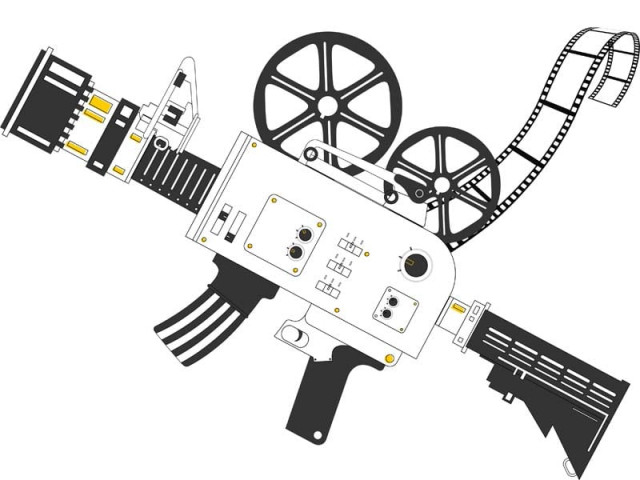Youth shoot life to humanise Lyari
Armed with cameras and fiery passion, these youngsters are reclaiming streets of restive neighbourhood from gangsters

Armed with cameras and fiery passion, these youngsters are reclaiming the streets of the restive neighbourhood from the gangsters. ILLUSTRATION/DESIGN: MOHSIN ALAM
Lyari is a dangerous place. Most people would never dream of venturing into the neighbourhood, even in broad daylight. Each time its name flashes across the television screen, there is news of gangsters or bloodshed or some violent crime.
The problem with this kind of narrative is that it only takes into account one side of the coin. Lyari is the oldest and most populous area of Karachi. It is home to over a million people, of various ethnic, social and religious backgrounds. True, it has its fair share of problems, with the gang culture and violence taking prominence over its diversity and liveliness. Yet these are a small part of what the neighbourhood actually is.
And now things are changing - for the better. Residents claim they are no longer afraid of the gangsters, their atrocities and sporadic clashes. They now want to reclaim and revive the social scene in the vibrant neighbourhood.
Read: Unleashing talent: Getting to know the ‘Humans of Lyari’
The youth, who until around a year ago, dared not leave the safety of their homes, have now equipped themselves with the weapons of choice to reclaim their neighbourhood. Armed with cameras, this group of young men and women capture real-life stories of people in the neighbourhood, their trials and tribulations, as well as their success-stories. The aim: to tell the true story of Lyari, something that is lost in the mainstream rhetoric. “Whenever the word, Lyari, springs up in any conversation, people are quick to associate it with bullets, bombs and fierce-looking gangsters,” says Fahim. “If there is some kind of cylinder blast or an accident that makes a loud noise, the mainstream media, without even bothering to confirm the veracity of the news, will report that a bomb blast has occurred in Lyari. But no one bothers to report the good things happening in town.” Is this not double standards of the mainstream media, he questions.
The youth are no longer waiting for others to come and tell their stories. They have taken matters into their own hands through the film-making and photo-journalism ventures.
Stories of Lyari
In the second week of September, the youth organised a seven-day film screening in the courtyard of the Abdullah Haroon College. The irony that the venue had served as a torture cell for one of the criminal gangs until a few years ago was not entirely lost on the audience. On the concluding day, the organisers had shortlisted six short films to be screened to a larger audience, based on the response they had received throughout the week. A projector screen was installed right in the middle of two Neem trees as the audience, comprising both men and women in almost equal numbers, sat on rugs.
A slight evening breeze embraced the audience as they sat in the fading moonlight. Even the power breakdown in the area
could not dampen the spirits of the audience or the organisers, the latter keeping the show running with a power generator.
Two lamps placed in diagonal corners of the courtyard made the ambience more intimidating as their light caressed the tip of leaves of the trees.
The Rising
“Our work is not confined to making films only,” explained Fahim, the main organiser. “We want the society to come forward, express and act.” He added that they wanted to reclaim the space that they had lost to the warring gangs. “We work under the banner of Mehrdar which means gateway to peace. Our philosophy is derived from slain social activist Sabeen Mahmud.”
Read: With only 3 days left, Pakistan votes for Sabeen's T2F for Dutch human rights prize
Lessons in Lyari
The first short film to be screened was Jaawar, which literally means ‘fear’. It narrates the story of a man who braved the violence in Lyari but unfortunately fell victim to a mental disorder.
The filmmakers described Jaawar as the story of most residents of Lyari, who had been forced to stay indoors during the clashes that often lasted several days. Its director, Ahsan Shah, said his team intended to give the world a glimpse of the physiological effects the people of Lyari had endured during the violence.
The second film was titled, Kaangi, which literally means ‘crow.’ The film opens with a funny scene of a typical teenage boy’s morning routine. The actor makes funny faces in front of the mirror while brushing his teeth, delivering dialogues of famous Bollywood movies while visibly perturbed by the itching in his underpants.
The film cruises through the boy’s daily routine of going out to buy some milk for breakfast. On the way, he encounters two boys stoning a crow chick that has landed on the ground after falling from a tree. Moments later, a cluster of crows come to rescue the chick. The crows hit the attackers in the head with their beaks and sharp claws. The young hero is jubilant - justice has been served.
In the next scene, two armed men enter a house, grab a young man from his collar, drag him to the middle of a street and shoot him multiple times until he dies. Everyone in the street, including the main character, witness the murder silently. The gunmen leave laughing, waving their guns in the air.
Read: Police encounter in Karachi leaves notorious Lyari gangster dead
The boy is greatly disturbed by the episode. He locks himself in the bathroom and wails in front of the mirror. He then goes up to the terrace and finds crows flying above a tree. He is lost in thought.
Kaangi’s message is for people to stand up against injustice and violence if they really want change. “The bond within the crow fraternity shows how people can get rid of notorious gangs,” says Muzammil, the host. The short, yet powerful, film had hit home. The audience sat mesmerised, some with misty eyes. A member of the audience shared his personal experience of a similar incident happening in front of him. He was ashamed he hadn’t done anything to prevent it.
Published in The Express Tribune, September 30th, 2015.



















COMMENTS
Comments are moderated and generally will be posted if they are on-topic and not abusive.
For more information, please see our Comments FAQ